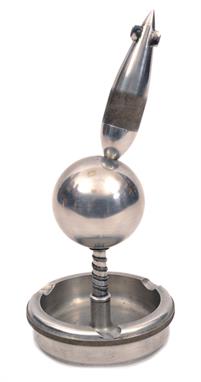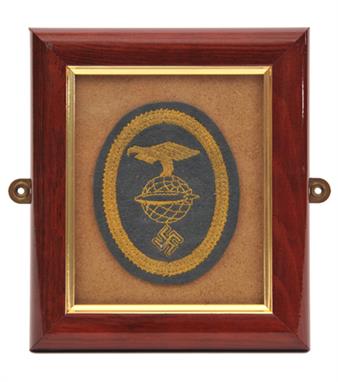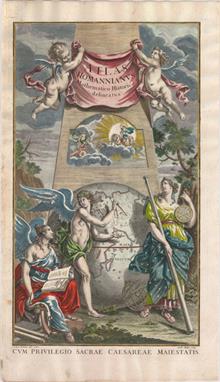We found 45695 price guide item(s) matching your search
There are 45695 lots that match your search criteria. Subscribe now to get instant access to the full price guide service.
Click here to subscribe- List
- Grid
-
45695 item(s)/page
A pair of late 19th century French silver mounted cut glass decanters approx. pint size, the flute cut necks over ovoid bodies etched with a ribbon tied floral swag, on a spiral fluted hallmarked silver pedestal foot with stiff leaf mount to the body, the neck and globe stopper with conforming mount, 9¾in. (25cm.) high, one rim chipped. (2)
A Victorian opaque glass and brass oil lamp the shaded yellow to white opaque glass font with floral and foliate relief moulded decoration, with brass Duplex double wick burner and yellow shaded etched globe shade, on a spiral turned column with conforming base, on an ebonised plinth, 24½in. (63cm.) high.
HEAVY CUT GLASS GLOBE AND SHAFT DECANTER AND STOPPER, ANOTHER of skittle form with similar design and a MODERN CONICAL EXAMPLE, TOGETHER WITH A COLLECTION OF GOOD QUALITY CUT AND STEMMED DRINKING GLASSES including a set of six `Stuart` HOCK GLASSES, set of four large tumblers, set of four brandy glasses etc,. EST 80-120
An Edwardian silver mounted cut glass scent bottle of globe form, with embossed scrollwork, silver decoration (London 1903), 1930s cut glass silver-topped scent bottle (London 1932) and a white metal model of a small sailing boat on an oak plinth, Edwardian scent bottle approximately 12cm in height (3)
A Victorian pavé set turquoise vinaigrette, the vinaigrette of hinged globe form, 18mm diameter, pavé set with rows of graduated turquoise cabochons. The interior with a pierced, gold, engraved, scroll form grille, to a polished gilded interior, a matched circular, domed brooch, and a pair of earrings, similarly set (4) CONDITION REPORT: Vary coloured turquoise with some obvious replacements. Some with surface damage or cracks. Nice tight hinge to the vinaigrette. Later roller catch to the brooch. Later posts to the earrings.
Montre Tintin Citime " Tintin Globe Trotter / L`Oreille cassée ". Montre à double fuseau éditée en novembre 1995. Présentée dans son coffret d`origine en bois (10 x 10 x 6,5 cm). Série limitée à 1500 exemplaires numéroté au dos de la montre n°448/1500 (bracelet cuir noir / cadran inox brillant). État neuf.
Montre Tintin Citime " Tintin Globe Trotter / L`Oreille cassée ". Montre à double fuseau éditée en novembre 1995. Présentée dans son coffret d`origine en bois (10 x 10 x 6,5 cm). Série limitée à 1500 exemplaires numéroté au dos de la montre n°841/1500 (bracelet cuir marron / cadran inox mat). État neuf.
[ROJAN] KODRIANSKAIA, Natalie. Le petit bonhomme venu du globe (en russe). Paris, 1954. КОДРЯНСКАЯ, Наталья. Глобусный человечек: Сказочное путешествие / Иллюстрации Федора РОЖАНКОВСКОГО. [Париж: Издание автора, 1954]. - 67, [3] c. : красоч. ил. ; 27,6 см. - В цветном иллюстрирован. издат. картонаже. Иллюстрации воспроизведены в технике хромолитографии. Коллекционная сохранность. Вторая детская книга Натальи Кодрянской, ученицы Алексея Ремизова. Одна из самых ярких детских книжек, иллюстрированных Рожанковским. Сеславинский, Рандеву 70
Antique Italian bronze figure depicting Atlas carrying the world on his shoulders, 19cm high, on an ormolu and marble base, overall height 32.5cm. For a similar 16th Century bronze figure minus the globe see Sotheby’s Milan sale of Important Paintings, Works of Art and Furniture formerly in the Collection of Palazzo Serristori, November 6th 2007 Lot 315 Some marks over the surface, probably caused during the casting, two chips to the pillar, screw in to top of globe possibly not original - ** General condition consistent with age
An Art Deco Desk Cigarette Lighter and Ashtray in Aluminium. A cigarette lighter and ashtray machined from aluminium alloy. The ash tray base (9cm diameter) has a central pillar which in turn supports a machined ball, representing the globe. Rising from the globe, is an elongated aerodynamic object with 4 tailfins; the top half can be removed to reveal the cigarette lighter. A nicely made and interesting piece.GC See Plate 1
A German post WW1 Deutsche Zeppelin–Reederei crew badge. A small pin back badge approx 20mm in size, of brass and bright blue enamel with ‘Deutsche Reederie Zeppelin’ to the outer circle, with stylised zeppelin over the globe inside. The silvered reverse marked ‘Paul Kust Berlin SW19’ VGC minor wear.
An original Tinplate Sign for the Chicago Century of Progress. (41cm x 28), predominantly in blues and yellows celebrating the centenary of the founding of Chicago. In the 4 corners is a symbol of the globe. A green outer border and a yellow inner border enclose several miniature scenes: Top left “1833, top right “1934” and between these dates is a picture showing a Conestoga Wagon leaving a palisaded town. Down the right border is a rail-road and train, down the left is an ocean liner and along the bottom is the text “A century of progress”. Bottom left corner shows a small speed boat, bottom right shows a racing car. The main picture, entitled “Chicago”, shows the exhibition centre, with the two lattice towers joined by the overhead railway in the background. In the foreground other significant structures, including the Travel and Transport Building. Overhead are the artist’s impressions of a generic passenger bi-plane and an airship. QGC some age wear overall, light denting/creasing.
An oval embroidered cloth badge. With dark blue background and gold coloured embroidery. The badge displays the logo of the original Deutsche Zeppelin Reederei (A globe with a Zeppelin superimposed, on top of the globe is perched an eagle facing left, and below the globe is a crooked cross). Mounted in a small glazed frame.GC For picture See the-saleroom.com
2 Souvenir phials of Veedol Oil drained from the tanks of Graf Zeppelin after the World Flight. 2 small glass phials, stoppered with cork, each in a cardboard lined metal canister (7cm high x 3cm diameter) with screw top. The paper labels proclaim “Veedol. Tydol. Guarantee. We guarantee that Veedol was used exclusively by the Graf Zeppelin and that this is an actual sample of the Veedol brought over and drained from her tanks. October 15, 1928. Tidewater Oil Company. New York”. The first canister, the label has been scraped, but the phial is intact. The second canister, the cork has leaked and the oil has soaked the cardboard and label, leaving the phial empty. Together with a Veedol Motorenöle Print leveraging the “Graf Zeppelin” World Flight. An interesting print of the Veedol Advert originally created by A.E.de Bruycker in 1929. The image shows an orange globe, girt around with Veedol Oil Cans, against a blue background. Floating serenely over the globe is the “Graf Zeppelin”. Original was printed by Hanseatischen Verlagsanstalt, Hamburg. This copy is framed, mounted and glazed (63cm x 87cm).GC See Plate 3
2 “Graf Zeppelin” Menu Cards for the Chicago Flight 1933. One menu card is a standard menu card, unused, showing a graphic at the top with the Graf Zeppelin over an alpine lake with the text “An bord des Luftschiffes Graf Zeppelin” above. Below the graphic is a blank panel bordered in blue, for the menu itself; to the left is a “LZ” Laurel wreath, below which is a German Weimar National Banner and the text “Sud und Nord Amerika Fahrt 1933”. To the right of the menu panel is another “LZ” Laurel wreath, below which is an American Banner and the words “Zur welt Ausstellung Chicago”. Standard Kurgarten Hotel text at the bottom. Slight damage to bottom left, and minor marks. The second menu card appears to be hand finished. Again it is unused. It is set against a grey background with text in white. At the top is “An bord des Luftschiffes Graf Zeppelin”. Below left, is a globe showing the triangular route from German to Brazil then Chicago, below right is an image of the “Graf Zeppelin”, bows to the left. In the centre is a “LZ” Shield trailing an ensign halyard bearing flags. At the top is the German National flag (black white and red tricolour), in the middle is the National Socialist flag and at the bottom is the US National Flag. To the left of the flags is a blank panel for the menu, and below the flags is the text “Fahrt sur welt Ausstellung Chicago 1933.” At the bottom is the Kurgarten Hotel detail. At the bottom left in very small text is “BHERZOG”. Interesting menus. GC
A very interesting Poster for Hamburg American Line. Appearing to advertise a Round the World cruise from New York starting on 19 Oct 1912. In black and white, extracted from the Scientific American dated 29 June 1912 (page 596). The advert shows a globe, with Schwaben floating above, and shirt-sleeved Uncle Sam resting on a spade. 2 World Cruises are advertised and also weekly trips to Jamaica and the Panama Canal.GC
Royal Airship Works Cardington, official Christmas Cards for 1920s. A Christmas Card of 1924, in a single side format, with suitable design of airship, globe, mooring tower and works with caption “With season’s greetings, from (signed Nellie), Royal Airship Works, Cardington, Bedfordshire”. VGC clean and 5 crested Christmas cards of more traditional form, from the Royal Airship Works, the inner pages showing R33, R101 and the Royal Airship Works (also signed Nellie, Nell etc) GC (6).
19th/20th C FIGURAL BRONZE ATLAS BOX w. FINIAL Old figural bronze sculpture depicting an Atlas scene with two nude males holding up a sphere on their backs. The globe with a covered box design and figural nude female holding flag finial design. Circa late 19th to early 20th century. Measures 13 3/4" height x 9" width x 5 1/4" depth (34.9cm x 22.8cm x 13.3cm). Total weight of approx. 4.05 kilograms.
Galle/Stradanus, 1592 Americae Retectio "This fascinating allegorical engraving commemorates the discovery of the New World. “Flora” (Florence) and “Janus” (Genoa) reveal a globe, that rests on the reclined body of Neptune (“Oceanus”), above a map of the coast of Italy. The title is suspended between portraits of Amerigo Vespucci and Christopher Columbus. Columbus’ ship, the “Santa Maria”, is shown leaving Genoa and approaching the West Indies and Vespucci’s ship is shown departing Italy (near his hometown of Florence) and sailing along the coast of South America. Magellan is alluded to on the globe where “Magellanica” is marked between the tip of South America and the huge southern continent. Mars displays the arms of Florence at upper left, while Neptune presents the arms of Genoa at right. Joannes Stradanus was a Flemish artist, who lived in Italy. He designed the four drawings in the Americae Retectio (including this frontispiece) and sent them to Antwerp where they were engraved by Adrian Collaert and published by Philippe Galle. According to Tooley, his work is one of the most important historical picture atlases, and is quite rare due to its ephemeral nature. This is the rare first state of three. The drawings were copied by Theodore De Bry, where the figures are shown in reverse." 11.2" W x 7.8" H There are some professional repairs in the blank margins, else fine.
Ptolemy/Mercator, 1704 Claudii Ptolemaei Tabulae Geographicae Orbis Terrarum Veteribus Cogniti This striking, classical title page is from Mercator`s edition of Ptolemy. It features two river gods in the foreground, and personifications of music, art, and learning are shown mapping the globe, while the angel of Fame trumpets above. Engraved by Jan van Vianen. Although Mercator is most renowned today for the projection he popularized and for first using the term "Atlas" for a collection of maps, he devoted much of his life to his Ptolemaic maps. This example is on a folio sized sheet and still attached to the table of contents for the atlas, published by Francois Halma and Guiljelmus van de Water. 9.3" W x 14.4" H Light soiling with a few small spots of foxing.
Weigel, Christopher 1720 Descriptio Orbis Antiqui in XLIV. Tabulis Exhibita a Io. Davide Koelero Hist. et Polit. P.P. Altdorfino Studio Atque Opera... This attractive title page is centered on Atlas, who is supporting a terrestrial globe (centered on Africa) on his shoulders and standing on an architectural structure. Flanking him are two rows of medallions representing the eastern hemisphere (at top left), the continents and the key countries in the eastern hemisphere. This title page graced David Koehler`s "Descriptio Orbis Antiqui", which was an atlas of the ancient world, published by Weigel. 7.5" W x 12.8" H A nice impression with a printer`s crease at left and light soiling. Remargined at right with old paper.
Homann, Johann Baptist 1720 Atlas Novus Terrarum Orbis Imperia, Regna et Status Exactis Tabulis Geographice Demonstrans... This boldly engraved sheet has many allegorical figures gathered in front of a large globe. Standing atop the globe, Atlas and Hercules hold up the heavens. In the background, bats and owls fly in the night sky while storks and eagles fly toward the sun. In the forefront is Neptune, god of seafaring, with his trident. To his right are Mercury, with winged helmet and caduceus, and Cybele, goddess of cities, representing civilization. Behind Cybele is Aeolus, god of the winds. From a later plate engraved by Michael Rossler circa 1720. 11" W x 18.9" H On watermarked paper with a small damp stain in the title cartouche, light soiling, primarily visible in the blank margins, and several edge tears, a few of which just touch the neatline.
Homann Heirs, 1762 Atlas Homannianus Mathematico-Historice Delineatus An evocative title page with a large globe and three female figures. The two angelic figures represent History and Geography, while the third classical muse is Urania, goddess of Astronomy or Navigation, standing by with a telescope, a compass, and an armillary sphere. The top of the map is balanced with a pair of putti holding the banner title, while below Apollo in his sun-chariot greets a personification of the North Star as night passes into day. Drawn by Johann Justin Preister and engraved by Andreas Hoffer. 10.8" W x 18.6" H Watermarked paper with marginal soiling.
-
45695 item(s)/page




















![[ROJAN] KODRIANSKAIA, Natalie. Le petit bonhomme venu du globe (en russe). Paris, 1954. КОДРЯНСКАЯ, Наталья. Глобусный челов](http://lot-images.atgmedia.com/SR/332/2891819/173-2013111416415_468x382.jpg)
































